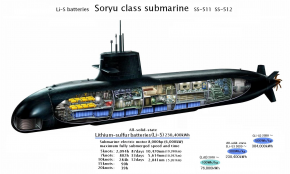I believe there seems to be a little confusion in the genuine number of subs that the navy should have.
- When I say SHOULD, I mean the 'ideal' number of subs that are required to achieve all of our sea denial, ISR, ASW, and other wartime roles.
The current number of 12 planned submarines is average, it's not great and not bad.
Unofficially the navy 'should' operate 24 submarines. Enabling 8 submarines on deployment to meet each of the aforementioned roles; 8 submarines on workup/short-term maintenance and 8 submarines in longer-term refit and deep maintenance. Once again following the rule of three.
I understand this number seems completely out of reach for the RAN, but we should consider the thought that, as all government projects are, the capability is defined, refined and adjusted to fit in between the political and pragmatic needs of the nation. Thus why the genuine number of subs is much higher at 24 than the 12 being built (yes the point that these are not 12 at once but 12 overall is correct and disappointing).
The reason this number is not published often or ever is that neither the government or the navy could sell that number to the public as spelling this idea out would lead to severe backlash to the current and projected numbers through arguments such as: "If that's true why do we only have 6 at the moment?" or "How could such a small nation ever meet that number?".
Similarly, 18 submarines can sometimes be seen in the public domain but is also seen as unpopular with politicians and the public.
* Please consider this number of 24 submarines in the context of a conflict within the Asia Pacific region, do you really think that Australia could afford not to at least attempt to achieve a force strength of this size?
- The ADF 'should' be structured for a worst-case scenario to ensure the safety of all Australians, not a watered-down capability (submarine number-wise I mean, the submarines will be exceptionally capable) that is subject to interpretation.
EDIT: John Newman's point that the Japanese submarines are "double-hulled" is most likely correct as they are, internal volume-wise, smaller than the Collins as they are currently outfitted.
Err...wha?
Where does 24 comes from? What strategic need is it meeting? Where does any hint of this need exist?
I get it, chatting with retired submariners, but the seeds to such an idea have to exist somewhere outside their own world. I cannot think of a single thing that suggests that Australia needs 24 submarines - and I can find strategic documentation that justifies aircraft carriers, multiple Divisions, a tripling of the F-35 fleet and a doubling of our DDG and FFG fleet. In fact, some of those I've actually sourced the justification for for the purposes of experimentation and the like. But nowhere can I think of something that justifies 24 boats. I'm struggling to find something (beyond a Government statement) that justifies 12 - but that's irrelevant. You say 18 boats is in the public domain - where?
Now - any senior submariner understands a hell of a lot more than driving a submarine or a sub squadron. The senior submariners I've dealt with in Russell are scary smart about a whole bunch of other fundamental inputs to capability. In fact, for my criticism of our SLG in some areas, they are almost all scary smart in these areas. I've seen
x-stars reject even coffee-table discussion of a new/expanded capability because it's not possible and not needed. In this case, 24 boats would never be raised - it's not needed nor is it possible.
To give an idea - what would the additional boats need?
- infrastructure. There isn't enough in Stirling for 12 - so you need to quadruple the base or build another 2 - 3 somewhere in Australia
- people. Arguable one of the most demanding and narrow-gated trade scheme. Equal at least to a fast-jet pilot - if not more. With significant psychological and physiological requirements that aren't found in most of the population. So, noting the workforce for Collins is fragile - where does the 4x additional people come from? That's what - 3/4 of the current Navy?
- build. Attack is being built about as fast as we can. You need to double the infrastructure and find qualified workers, themselves a reasonably rare group of people. Specific hand skills + security classifications?
On top of all this is increasing SEA 1000's budget by ~2.5. Normally I'd do 1.8 as there is cost savings in greater numbers - but in this case we need to fund additional facilities, workers and crew. So we are looking at $200 bn in the next 20 years for acquisition. Now the good news is we can do this.
As long as you delete the surface fleet, reduce the RAAF to some Growlers, C-17s and no more than a Sqn of F-35 and make Army a light Bde.
No submariner beyond some junior jube would suggest such a thing. Defeating the ADF becomes really easy - just build an ASW force and be done with it.
This is like saying Army needs to be an Corps with 2 Inf Div, an Armoured Div, an Arty Div and enablers - a'la V Corps of 1989. Useful? No. Feasible? No. Logical? No. Needed? No. Justifiable? No. Ever said by any senior people? No....
Edit: Ahhh... I see
@ngatimozart has brought out the bold green to ask the question. Delete this post if you need to, oh great moderator.

